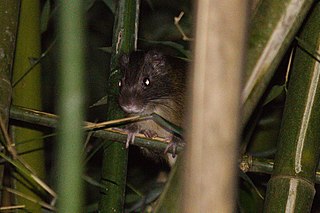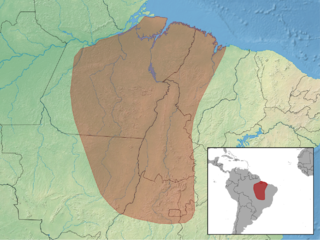
The painted tree-rat is a species of spiny rat from Brazil, restricted to north-eastern Bahia in eastern Brazil. It is the only species in the genus Callistomys.

The white-faced spiny tree-rat is a spiny rat species from South America. It is found in Brazil, French Guiana, Guyana and Suriname.

The Atlantic bamboo rat, or southern bamboo rat, is a spiny rat species found in humid tropical forests in Argentina, Brazil and Paraguay. It is the only member of the genus Kannabateomys.
The tuft-tailed spiny tree rat is a spiny rat species from Brazil south of the Amazon River, where it has been found in grassland and gallery forest. It is the only species in the genus Lonchothrix. Very little is known about this rodent. It is small with an average adult weight of about 138 grams. It is nocturnal and solitary in habits.
The long-tailed armored tree-rat, is a spiny rat species from South America. It is found in Brazil, with a population in Ecuador which is referable either to this species or to Makalata didelphoides. Initially considered a large form of the latter species, it actually represents a distinct species as supported by morphological and molecular characters.
The tufted-tailed spiny tree-rat or furtive spiny tree-rat is a spiny rat species known from Amazonas, northwestern Brazil, where it is found in tropical rainforest. The species is arboreal.
The Pará spiny tree rat or Surinam spiny tree rat, is a spiny rat species found in Brazil.

The Guyenne spiny-rat or Cayenne spiny rat, is a spiny rat species found in Brazil, Colombia, French Guiana, Guyana, Suriname and Venezuela.
Cuvier's spiny-rat is a spiny rat species found in Brazil, French Guiana, Guyana, Peru and Suriname.
The stiff-spine spiny-rat or Tefe spiny rat, is a spiny rat species found in Brazil and Colombia.
Goeldi's spiny-rat is a spiny rat species found in Brazil.
The Guyanan spiny-rat is a spiny rat species found in Brazil, Guyana and Venezuela. The species was first described by George Henry Hamilton Tate in 1939.
The Kulina spiny-rat or Javari spiny rat, is a spiny rat species found in Brazil and Peru.

Robert's spiny-rat or Para spiny rat, is a spiny rat species found in Brazil. This species is named after the collector Alphonso Robert, who collected the holotype of this species in 1901.

Mesomys is a genus of South American spiny rats in the family Echimyidae.
Maria Nazareth Ferreira da Silva is a zoologist from Manaus, Brazil
The Brazilian spiny tree rat is a species of rodent in the family Echimyidae. It is found in Bolivia, Brazil, French Guiana, Guyana, Suriname and Venezuela, where it lives in lowland tropical rainforest. There is also a population in Ecuador which is referable either to this species or to Makalata macrurus. It is nocturnal, and eats seeds.
The woolly-headed spiny tree-rat is a species of rodent in the family Echimyidae. It is endemic to Peru.
The dusky spiny tree rat is a species of rodent in the family Echimyidae. It is endemic to Brazil.

Echimyini is a tribe of echimyid rodents, proposed in 2016, and containing 13 extant genera: all of the tree rats Echimys, Phyllomys, Makalata, Pattonomys, Toromys, Diplomys, Santamartamys, and Isothrix, the long recognized dactylomines Dactylomys, Olallamys, and Kannabateomys, and the enigmatic and previously classified as eumysopines Lonchothrix and Mesomys. All these spiny rats genera are arboreal. Worth of note, the arboreal genus Callistomys – the painted-tree rat – does not belong to the tribe Echimyini. Because it is phylogenetically closer to Myocastor, Hoplomys, Proechimys, and Thrichomys than to the above-mentioned Echimyini genera, it is classified in the tribe Myocastorini.








